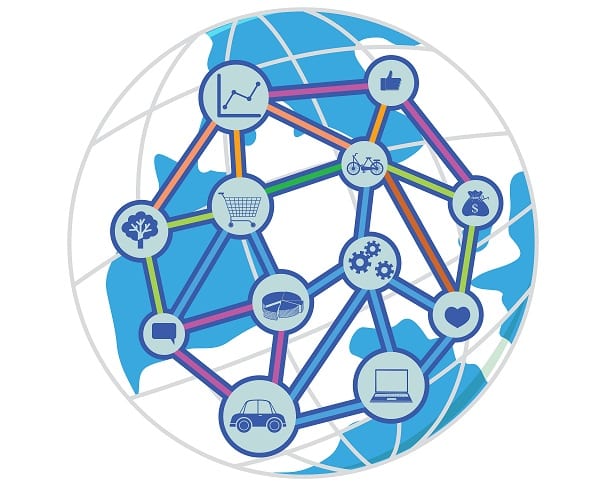
Distribution channels are critical for getting your product or service to customers. They could make or break your marketing strategy.
That’s why we want to discuss everything you should know about distribution channels in this article.
Here are a few of what you’ll learn:
- How distribution channels work
- The main types of distribution channels
- Pros and cons of each distribution method.
- Real-world examples of distribution channels businesses use.
- How to select the best distribution channel for your specific product.
Whether you sell directly to customers or through retailers, this article will help you master distribution channels. The knowledge will guide you to make informed choices so you can run your business more efficiently.
Let’s show you how to take your products to market like a pro!
How Distribution Channels Work
Before discussing the different distribution channel types, let’s briefly examine how they work.
A distribution channel is a product’s path from production to the final consumer. It involves various intermediaries who help move the product through the distribution process.
The most basic distribution channel flows like this:
- The manufacturer makes the products.
- They sell the products in bulk at a low price to a wholesaler.
- The wholesaler sells the products in smaller quantities at a higher price to retailers.
- The retail dealers finally sell them to the end consumer at the highest price.
So, wholesalers and retailers act as intermediaries between the manufacturer and the consumer. This model helps widen distribution and reach more customers.
The length of the distribution channel impacts a few key factors, such as:
- Control – Shorter channels allow more control over distribution. Longer ones have lower control.
- Margin – Businesses make less profit with more intermediaries.
- Adaptability – It’s easier to change strategies with shorter channels.
- Investment – Direct channels require infrastructure to sell directly. Indirect channels leverage existing networks.
Distribution Channel Levels
The number of intermediary levels determines the “level” of the distribution channel. The major distribution channel levels are:
- Zero-level – Direct sales from manufacturer to consumer.
- One-level – Adds one intermediary like a retailer.
- Two-level – Wholesaler and retailer act as intermediaries.
So, a distribution channel isn’t a single entity – it’s the distribution chain of manufacturers, intermediaries or channel partners, and final sellers working together to bring a product to market.
Types of Distribution Channels
Now that we’ve got the basics down, let’s explore the main types of distribution channels in marketing!
The three primary categories are:
- Direct distribution channels
- Indirect distribution channels
- Hybrid distribution channels
Let’s start with the main two:
Direct distribution channels involve selling directly to the end-user or customer without any intermediaries.
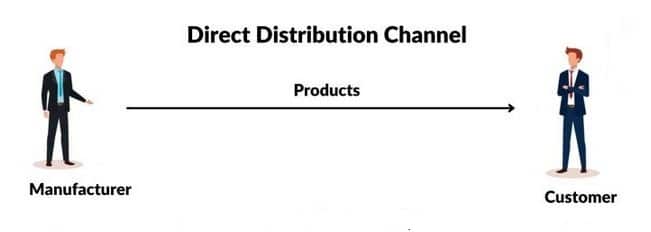
Source: marketing91.com
Some examples include:
- Brick-and-mortar retail stores
- Your own e-commerce site
- Direct mail/catalog sales
- Pop-up shops
Benefits
- More control over distribution
- Build direct relationships with customers
- Higher profit margins
Drawbacks
- Large upfront investment in infrastructure and inventory
- Must handle all sales, marketing, and customer service
Indirect distribution channels involve various distribution partners or intermediaries who help sell your product to consumers.
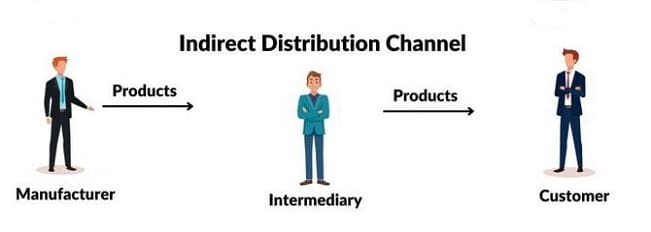
- Selling to wholesalers who then sell to retailers
- Using Amazon Fulfillment to store and ship products
- Partnering with retailers to get your products to the customers
Benefits
- Wider reach and distribution through intermediaries’ networks
- Lower upfront investment by leveraging existing infrastructure
- Intermediaries handle most sales and logistics
Drawbacks
- Less control over distribution and brand positioning
- Lower profit margins due to intermediary markups
Hybrid channels utilize both direct and indirect methods for product distribution. Many large companies use this omnichannel strategy to maximize reach.
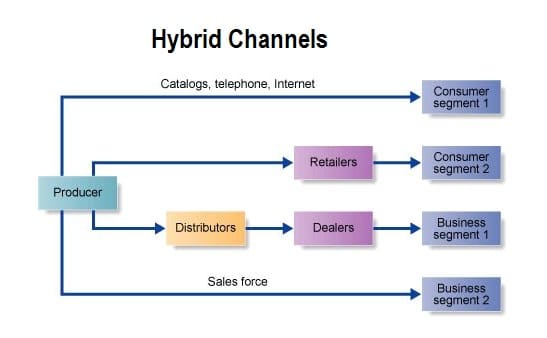
Choosing the Right Distribution Channel
Selecting the right distribution channels is a big decision that impacts your marketing success. Here are some tips for choosing the best channels for your products and business:
Consider your product characteristics
- Does it require special storage or handling? Direct channels may be better if you sell a product with any of these requirements.
- Is it high cost or complex? Consultative selling through direct channels may work best.
- Is it a commodity product? Indirect channels provide a wider reach.
Evaluate required investment
- Direct channels of distribution require infrastructure like stores, e-commerce platforms, and sales teams.
- Indirect channels leverage existing networks, so they require lower investment.
- Hybrid models balance investment between direct and indirect channels.
Assess the target customer base
- Direct channels allow for building direct customer relationships. They are great for targeted demographics.
- Indirect channels cast a wider net to reach broad customer segments.
- Businesses selling to other businesses (B2B) often use direct sales teams.
Align with business resources
- Direct channels give more control but require more resources to handle sales operations.
- Third-party retail channels reduce resource requirements through outsourcing.
- Balance channel mix based on available business resources.
For exclusive products, selective distribution limits sales to specific retailers. This maintains quality and brand positioning. Luxury goods often use selective distribution.
The ideal strategy is determining which distribution channels are right for your specific products and business model.
Evaluate all options and choose a distribution channel that maximizes reach while aligning with your resources and capabilities. This balanced approach leads to sales and marketing success!
Examples of Distribution Channels
Let’s look at some real-world examples to see how companies utilize distribution channels for different products:
Consumer Packaged Goods
Major brands like P&G and Coca-Cola primarily use indirect distribution through wholesalers and retailers. This allows massive-scale distribution to make products widely available everywhere.
For example, Coca-Cola sells beverage concentrates to bottlers who produce, bottle, and distribute them to stores for consumers to purchase.
Fashion and Apparel
Clothing brands employ hybrid distribution with both direct and indirect channels. Their own retail stores and e-commerce sites provide direct customer access.
Meanwhile, department stores, boutiques, and other retailers serve as indirect partners to expand reach. Levi’s exemplifies this approach, selling through their stores, sites, and third-party retailers.
Tech Products
Many tech companies sell directly to consumers online. Apple sells through its website and stores. Amazon Marketplace offers a platform for third-party tech sales. However, many devices still require retail distribution due to higher pricing and the need for customer education.
Media and Entertainment
Media content from books to movies to games has largely shifted to direct digital distribution. Platforms like Kindle, Netflix, and Steam allow direct sales and delivery of digital products. But, physical books, movies, and games still rely heavily on retail distribution.
Business to Business (B2B)
For business products and services, companies often use direct field sales teams to build relationships with enterprise clients.
This consultative approach requires direct interaction. However, distributors and resellers act as indirect channels to expand B2B reach. IT vendors like Cisco leverage both strategies.
Services
Professional services like finance, consulting, healthcare, and more require direct sales pitches and meetings to demonstrate expertise.
However, aggregator platforms also enable indirect access to customers. Doctors may join health networks to access patients while still serving them directly.
In summary, many companies employ hybrid distribution strategies using direct and indirect channels tailored to their products and markets. Mapping the customer journey determines the ideal mix.
E-commerce and Online Marketplaces
The internet has revolutionized distribution channels, empowering companies to sell their products directly to consumers online. E-commerce and online marketplaces have become essential direct sales and marketing channels.
According to eMarketer, by 2025, e-commerce sales are predicted to account for nearly 24% of all retail sales in the United States.
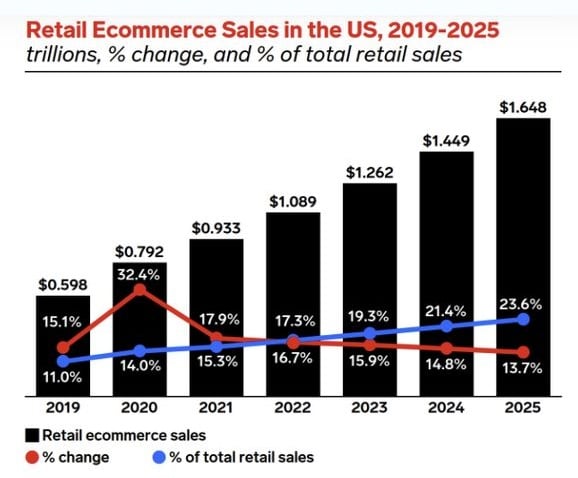
Major brands use their own e-commerce sites to sell directly to customers. Nike, Apple, Samsung, and more all generate significant sales through their owned online stores. This direct distribution allows higher margins and control over the customer experience.
Meanwhile, online marketplaces like Amazon and eBay provide a platform for third-party merchants to sell products easily. Small businesses can quickly scale distribution through these marketplaces versus building their infrastructure.
SaaS companies like Salesforce, HubSpot, and others sell subscriptions directly through their sites. Digital downloads like apps, books, and software are delivered instantly.
For physical products, e-commerce paired with fulfillment and logistics advances enables fast direct-to-consumer delivery.
Effective e-commerce involves dedicated digital marketing efforts, including:
- SEO to drive organic site traffic
- Pay-per-click advertising
- Marketing emails and retargeting
Omnichannel retailers invest heavily in localized inventory and fast shipping to deliver a premium customer experience.
Both B2C and B2B companies now generate significant revenue from e-commerce and online transactions. It has never been easier for a young brand to grow its business online through direct distribution.
In summary, the emergence of e-commerce provides limitless potential to access customers directly. Businesses must still focus on providing a stellar customer experience across channels. User experience, fulfillment, and customer service are critical.
A savvy e-commerce strategy is essential for established brands and startups to remain competitive and achieve scale. The internet has unlocked direct global access to consumers and the possibilities are endless!
Trends in Distribution Channels
Distribution channels continue to evolve rapidly thanks to technology and changing consumer behavior. Let’s look at some current trends shaping the future of getting products to customers:
- Direct-to-consumer – More brands are exploring direct sales channels, from opening their stores to branded e-commerce. Nike and Warby Parker show how powerful owning the customer experience can be.
- Omnichannel commerce – Retailers are pursuing true omnichannel strategies with seamless sales across in-store, online, mobile, etc. Walmart and Target are leaders here.
- Online marketplaces – Platforms like Amazon, eBay, and Etsy remain go-to online sales channels, especially for small sellers. Their massive reach expands distribution.
- Social commerce – Social media platforms are launching integrated shopping. Instagram Checkout and livestream selling open new direct sales channels.
- Subscription models – Subscription commerce startups like Dollar Shave Club ship products directly on a schedule. This guarantees recurring sales.
- Pop-up shops – Temporary retail spaces allow flexible physical footprints to drive awareness and sales. They can easily tie into broader direct-to-consumer strategies.
- Delivery innovations – New ultra-fast shipping options from Amazon and startup delivery services raise consumer expectations of speed and convenience.
To keep pace, brands must develop multiple distribution channels tailored to their products and customers. The leaders will creatively leverage both emerging technologies and traditional retail models.
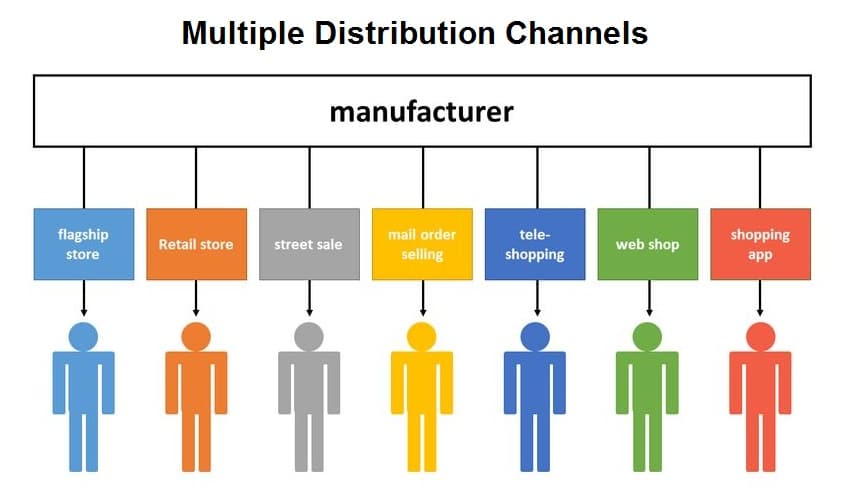
Source: ionos.com
Owning the entire customer experience across the journey – from initial awareness to purchase and beyond – is more important than ever. Make sure your distribution strategies align with customer needs at each touchpoint.
The possibilities to access customers directly are exploding thanks to e-commerce and omni-channel capabilities. Small disruptors can challenge established giants faster than ever. Distribution innovation is imperative for all brands today.
Challenges and Pitfalls of Distribution Channels
While effective distribution is critical, it comes with unique challenges that brands must navigate. Let’s explore some common pitfalls and solutions:
- Channel conflict – When selling through multiple channels, conflicts can arise around pricing, promotions, etc. Maintain alignment through transparent communication and win-win incentives.
- Free riders – Some resellers try to leverage brand equity without putting in the work. Limit authorized partners and monitor branding compliance.
- Margin erosion – Adding more intermediaries shrinks profits. Do a cost-benefit analysis when expanding distribution and limiting partners.
- Inventory management – More retail partners mean more forecasting complexity and excess stock across the chain. Invest in supply chain technology and improve visibility.
- Customer ownership – With indirect retail sales, the customer relationship belongs to the reseller. Brands must work harder to retain awareness and loyalty.
- Data fragmentation – Omnichannel distribution splits customer data across channels. Build an integrated CRM system and unified profiles.
- Fast-changing technology – Distribution methods evolve quickly, challenging brands to adapt constantly. Stay on top of trends and pilot new channels aggressively.
- Geographic complexity – Global brands face varied regional partner dynamics, regulations, and customer preferences. Pursue localized strategies that balance standardization and localization.
Complex distribution networks require financial investment and a dedicated organizational focus on channel operations. The increased reach and revenue come with distinct challenges.
While tricky at times, most pitfalls can be anticipated and managed with careful strategic planning and execution. The key is taking an omnichannel approach to serve customers seamlessly however they choose to engage.
Sustainability in Distribution
Sustainability has become a strategic priority for companies as both consumers and business owners increasingly factor environmental impact into purchase decisions. This applies to distribution operations as well.
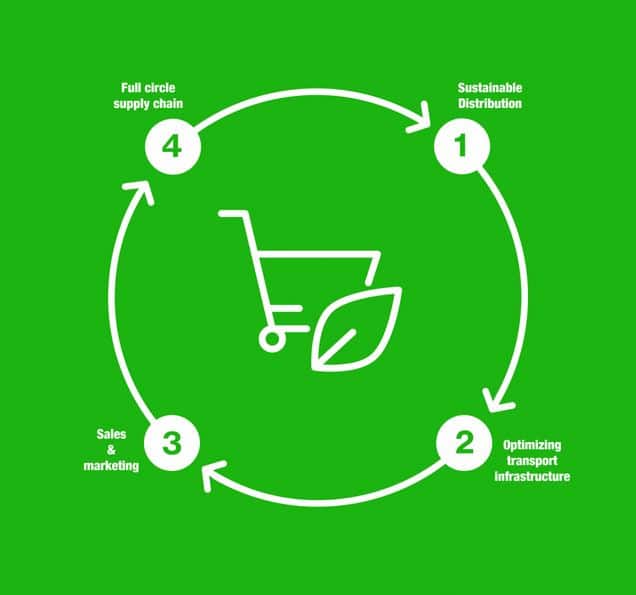
Source: sustainabilityguide.eu
According to this IBM report, nearly 80% of consumers say sustainability is an important factor when deciding which brands to purchase from.
Brands today must examine their distribution channels through a sustainability lens. Key focus areas include:
- Reducing carbon emissions across supply chains through efficiencies and clean energy
- Rethinking packaging to minimize waste
- Leveraging greener transportation modes and fleet vehicles
- Choosing eco-friendly production and fulfillment partners
- Incorporating sustainability messaging in channel marketing
Patagonia stands out as a brand purpose-built around sustainability. Their products are made from recycled materials whenever possible. They focus on quality and durability to discourage disposable consumption. Patagonia also offers repairs to extend product lifecycles.
Consumer giants like Walmart and IKEA have implemented ambitious sustainability initiatives around renewable energy, reduced packaging, and investing in circular supply chain models.
Both B2C and B2B brands must holistically embed sustainability into business operations, including distribution. Consumers and business buyers are demanding it.
Eco-friendly practices in distribution can also drive cost savings through efficiencies. Sustainability ultimately supports the triple bottom line – people, planet, and profits.
The widespread shift towards online shopping makes streamlining and greening fulfillment and logistics all the more important. This will require collective effort across industries.
Brands that lead the way in sustainable distribution will earn customer loyalty and goodwill. It has become a competitive advantage and cost of entry with global commerce. Are you on board?
Conclusion
As technologies and shopping habits change, you should review your channel strategy accordingly. With smart distribution choices and marketing, you can grow your business!